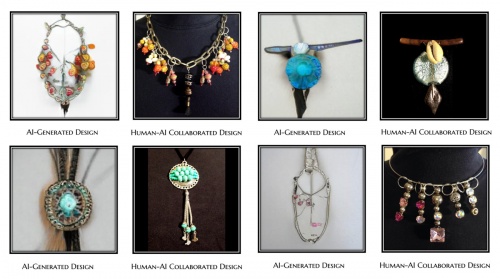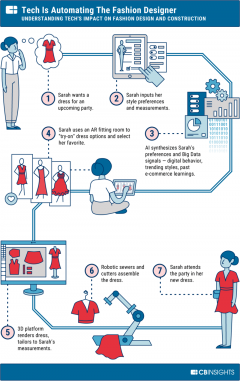Fast Fashion
Fast Fashion is a popular business model that focuses on mass production, design, and marketing. The manufacturing relies on replicating trendy styles and low-quality materials to produce inexpensive clothing styles for the general public. These cheaply-made, trendy pieces have resulted in a large-scale movement within the fashion industry. [1] This movement originated in the 1960s as a way to promote paper and resulted in a push towards using cheap materials and disposable clothing. In the present day, fast fashion is known for efficient supply chains, responsive design methods, inexpensive labor, the use of sweatshops, and bulk low-labor manufacturing industries in South, South East, and East Asia. [2] Companies like Uniqlo, H&M, and Zara built these business models, based on inexpensive clothing from efficient production lines, to create more seasonal/trendy designs that are continuously marketed to fashion-conscious consumers. [3]

Contents
Origins
The earliest version of fast fashion starts back in the 1960s with the paper clothing trend, where one viral marketing campaign instigated the movement through paper napkins. In an attempt to promote their new Dura-Weve material in 1966, Scott Paper Company created two styles of shift dresses. In eight months, 500,000 units were sold; by the end of 1966 national sales of paper clothes had topped $3.5 million. These paper clothes were designed to be easily disposable and reflected fashion as an artistic statement. [5] In 1968 paper clothing went out of style due to a shift in design trends and a cultural focus on the environment. [6] This trend prompted fast fashion businesses during the late 20th century to manufacture cloth cheaper and more efficiently, utilizing new materials like polyester and nylon.
Current Business practices

Some of the current popular fast fashion brands include Zara, Shein, Uniqulo, H&M, ASOS, and Topshop. These businesses rely heavily on cheap labor and inexpensive global trade to quickly develop and construct clothing.
In 2004, the Multifiber Arrangement (MFA) was phased out, which has had a large impact on fast fashion. The MFA imposed quotas and restricted clothing exports from developing countries to developed countries, and without these quotas, importing clothing is now based on labor costs, local input materials, tariffs, and a firm's ability to produce new clothing. [8] Due to the new focus primarily on labor costs, businesses have been able to lower prices.
Fast fashion brands usually develop their seasonal clothing up to nine months in advance. Then, while the clothes are selling, companies rely on sales data, store managers, industry publications, the internet, and trend spotters. During the season, clothing can be created in four to five weeks and can be modified in two weeks. The traditional industry model might take up to six months to complete the same process. Creative teams thus focus on "products for the current season by creating constant variation, expanding on successful product items and continuing in-season development, and on the following season and year by selecting the fabrics and product mix that would be the basis for an initial collection." Due to the short design cycle, companies are able to continually manufacture merchandise during the fashion season instead of before the season starts. [9]
Technology in Fast Fashion Practices
Data Collection
Nowadays, fashion brands, including fast fashion and high-brand names use modern technology to understand their market and customers better. Through online data collection, some companies can use artificial intelligence to reshape the company's approach to product design and development, which allows them to predict what customers will want to look for and buy next. [10]. Big data analysis has already begun to take on a significant role in forecasting customer behavior and buying patterns. The brands with the resources and funds to obtain these analytics have a competitive edge over other smaller businesses. Because of these big data analytics, fast fashion brands can revamp their marketing tactics to find and create the best, most profitable products to bring to their consumers. Currently, to be successful within the fashion industry, brands need to predict fashion and industry trends to stay in touch with the ever-changing consumer preferences. [11]. Big Data analytics can provide companies many useful services, mainly through analyzing trends, identifying target markets, and improving cross-selling. Helping companies understand market trends by using data-driven sentiment analysis solutions on social media and other platforms ultimately aids them in marketing their products correctly.
Implementation of AI

AI is becoming the fore-front force in fast fashion practices. From design, manufacturing, logistic supply chain, and marketing, AI in the fashion industry is starting to transform how companies operate and maximize their profits. In the age of digitalization, AI and machine learning (ML) based technologies are providing automated solutions to provide the most efficient, cost-saving methods.
Designing Clothes
AI can act as a clothing designer because it can reduce forecasting errors by detecting new, in-demand trends. Because fashion trends vary on such a fast face, AI designers need to keep up with the latest styles by analyzing designs through images to copying those popular styles. [13]. Moreover, because the product life cycle is short and there can be up to 10,000 unique items (measured in stock-keeping units) to model, it is hard to forecast future trends using traditional means in a short amount of time. AI has allowed for forecasting despite these conditions and often includes multiple models working in conjunction [14]
AI can also directly design clothing items. One example of this is when Pinar Yanardag and Emily Salvador utilized AI to create a little black dress. They trained a GAN (Generative Adversarial Network) which generated designs then humans would pick features from the designs to incorporate into the final design. The final design was then handmade[15] Moreover, jewelry has been created using a similar process. [16]
Manufacturing
AI also plays a role in manufacturing and supply chains. AI can perform labor-intensive tasks such as sewing and sorting with a faster speed and accuracy, therefore reducing the extra cost of employees. Fast fashion companies can also mass-produce their clothing because AI-enabled machines and robots can perfectly stitch the fabrics while detecting any faults in the material. In inventory and supply chain management, AI speeds up the routes the products take by cutting the logistic supplies and shipping costs. Using these benefits provided by AI, companies can have specific logistics and supply chain processes that offer faster delivery options and can find alternate routes for vehicles if derailed by unforeseen circumstances. [18]. Manufacturing marketplaces can also utilize AI to assess whether or not designs are feasible and can provide estimates on cost and production time, which potentially eliminates long periods of communication with suppliers. This is a crucial role for mass production because the more products they can create and send out ultimately equals more profit for the business. Now, vendors tend to be less responsive to small-quantity orders unless they are specifically set up for that scale because of the shift towards mass production and the use of AI methods. [19].
Virtual Fitting Rooms
AI also provides virtual fitting rooms in which customers can virtually try on items. To achieve this, consumers provide their personal data such as their height, weight, and fit preferences, and this information is used in conjunction with AI and 3D cameras. These algorithms combine customer information with existing databases of various items, styles, and sizes to recommend the best products from brand partners to consumers. This allows for personalized recommendations and easier access to products with contactless methods. [20].
References
- ↑ Linden, A. (2016). An Analysis of the Fast Fashion Industry. Retrieved 10 March 2021, from https://digitalcommons.bard.edu/cgi/viewcontent.cgi?article=1033&context=senproj_f2016
- ↑ Joy, A. (2012). Fast Fashion, Sustainability, and the Ethical Appeal of Luxury Brands. Retrieved 12 March 2021, from https://www3.nd.edu/~jsherry/pdf/2012/FastFashionSustainability.pdf
- ↑ Gustashaw, M. (20 March 2017). Uniqlo Is Going to Start Producing Clothing at Zara Speeds. Retrieved 12 March 2021, from https://www.gq.com/story/uniqlo-fast-fashion-speed-zara-competition
- ↑ Stanton, A. (2019). What is Fast Fashion Anyway? Retrieved 12 March 2021, from https://www.thegoodtrade.com/features/what-is-fast-fashion
- ↑ Buck, S. (27 November 2017). This paper clothing trend of the 1960s was the early version of fast fashion. Retrieved 11 March 2021, from https://timeline.com/paper-fashion-1960s-43dd00590bce
- ↑ Cunningham, Patricia A., and Susan Voso Lab. Dress and Popular Culture. Bowling Green State University Popular Press, 1991.
- ↑ Pankaj Ghemawat and Jose Luis Nueno Iniesta. ZARA: Fast Fashion. Boston: Harvard Business Publishing, 2003.
- ↑ Alam, M. S., et al. “The Apparel Industry in the Post‐Multifiber Arrangement Environment: A Review.” Wiley Online Library, John Wiley & Sons, Ltd, 10 Oct. 2018, onlinelibrary.wiley.com/doi/abs/10.1111/rode.12556.
- ↑ Pankaj Ghemawat and Jose Luis Nueno Iniesta. ZARA: Fast Fashion. Boston: Harvard Business Publishing, 2003.
- ↑ CB Insights. (13 October 2020). The Future Of Fashion: From Design To Merchandising, How Tech Is Reshaping The Industry. Retrieved 12 March 2021, from https://www.cbinsights.com/research/fashion-tech-future-trends/#:~:text=And%20today%2C%20fashion%20technology%20is,up%20every%20aspect%20of%20fashion
- ↑ Business Wire. (12 June 2020). How Big Data Analytics Is Changing the Face of Fashion Retail. Retrieved 12 March 2021, from https://www.businesswire.com/news/home/20200612005108/en/How-Big-Data-Analytics-Is-Changing-the-Face-of-Fashion-Retail-Quantzig%E2%80%99s-Experts-Share-Valuable-Insights-in-Their-Recent-Article#:~:text=In%20the%20fashion%20industry%2C%20data,customer%20behavior%20and%20buying%20patterns.&text=Big%20data%20analytics%20is%20helping,to%20bring%20to%20the%20market
- ↑ Yanardag, Pinar, and Erin Genia. How to Generate (Almost) Anything, 2019, howtogeneratealmostanything.com/jewelry/2019/01/30/episode11.html.
- ↑ Bisen, V. (18 January 2020). How AI is Changing Fashion: Impact on the Industry with Use Cases. Retrieved 12 March 2021, from https://medium.com/vsinghbisen/how-ai-is-changing-fashion-impact-on-the-industry-with-use-cases-76f20fc5d93f
- ↑ Choi, Tsan-Ming, et al. “Fast Fashion Sales Forecasting with Limited Data and Time.” Decision Support Systems, vol. 59, 2014, pp. 84–92., doi:10.1016/j.dss.2013.10.008.
- ↑ Yanardag, Pinar, and Emily Salvador. The Little Black Dress, https://lbd-ai.com/.
- ↑ Yanardag, Pinar, and Erin Genia. How to Generate (Almost) Anything, 2019, htps://howtogeneratealmostanything.com/jewelry/2019/01/30/episode11.html.
- ↑ CB Insights. (13 October 2020). The Future Of Fashion: From Design To Merchandising, How Tech Is Reshaping The Industry. Retrieved 12 March 2021, from https://www.cbinsights.com/research/fashion-tech-future-trends/#:~:text=And%20today%2C%20fashion%20technology%20is,up%20every%20aspect%20of%20fashion
- ↑ Schmelzer, R. (16 July 2019). The Fashion Industry is Getting More Intelligent with AI. Retrieved 12 March 2021, from https://www.forbes.com/sites/cognitiveworld/2019/07/16/the-fashion-industry-is-getting-more-intelligent-with-ai/?sh=15d0d973c74d
- ↑ CB Insights. (13 October 2020). The Future Of Fashion: From Design To Merchandising, How Tech Is Reshaping The Industry. Retrieved 12 March 2021, from https://www.cbinsights.com/research/fashion-tech-future-trends/#:~:text=And%20today%2C%20fashion%20technology%20is,up%20every%20aspect%20of%20fashion
- ↑ Shemar, K. (August 2020). Fashion & AI: the privacy of virtual fitting rooms. Retrieved 12 March 2021, from https://www.gerrishlegal.com/legal-blog/2020/9/8/fashion-amp-ai-the-privacy-of-virtual-fitting-rooms
